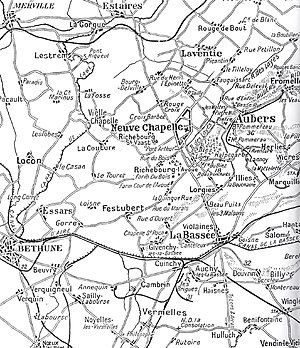Battle of Aubers
| Battle of Aubers Ridge | |||||||
|---|---|---|---|---|---|---|---|
| Part of the Second Battle of Artois of the Western Front of World War I | |||||||
|
Aubers Ridge and Festubert, 1915 |
|||||||
|
|||||||
| Belligerents | |||||||
|
|
|||||||
| Commanders and leaders | |||||||
|
|
|
||||||
| Strength | |||||||
| Unknown | Unknown | ||||||
| Casualties and losses | |||||||
| 9 May: 11,161 | 9 May: 902 (partial) | ||||||
The Battle of Aubers Ridge was a British offensive on the Western Front on 9 May 1915 during World War I. The battle was part of the British contribution to the Second Battle of Artois, a Franco-British offensive intended to exploit the German diversion of troops to the Eastern Front. The French Tenth Army was to attack the German 6th Army north of Arras and capture Vimy Ridge, preparatory to an advance on Cambrai and Douai. The British First Army on the left (northern) flank of the Tenth Army, was to attack on the same day and widen the gap in the German defences expected to be made by the Tenth Army and to prevent German troops from being moved south of La Bassée canal.
The battle was the initial British component of the combined Anglo-French offensive known as the Second Battle of Artois. The French commander-in-chief, Joseph Joffre, had enquired of Sir John French, commander of the British Expeditionary Force, if British units could support a French offensive into the Douai Plain around late April or early May 1915. The immediate French objectives were to capture the heights at Notre Dame de Lorette and the Vimy Ridge. The British First Army was further north, between La Bassée and Ypres (Belgium). It was decided that the British forces would attack in the southern half of their front line, near the village of Laventie. Their objective in the flat and poorly drained terrain was Aubers Ridge, an area of slightly higher ground 2–3 kilometres (1.2–1.9 mi) wide marked by the villages of Aubers, Fromelles and Le Maisnil. The area had been attacked in the Battle of Neuve Chapelle two months earlier. The battle marked the second use of specialist Royal Engineer tunnelling companies, when men of 173rd Tunnelling Company tunnelled under no man's land and planted mines under the German defences to be blown at zero hour.
...
Wikipedia

